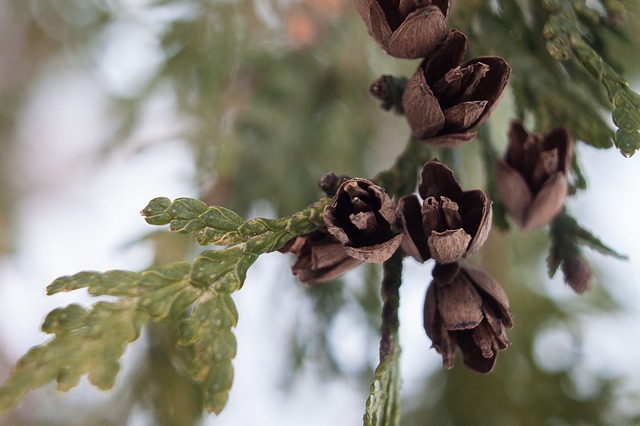Northern white Cedar is an evergreen tree, 12-15 (rarely 18) m high. The bark is grayish-brown, more often dark brown. The leaves are arranged oppositely, small, scaly, pressed to flat branches, needle-like on young shoots. Propagated by seeds. Male cones are yellow, round, sessile, arranged in axils; female cones are light green, oval-oval, located on the tips of leafy shoots. Ripe cones (12 mm long), light brown or brown-dark brown, bent down, the leathery woody scales overlap. The cones mature in the first year, the scales open and the two-winged seeds are released. Pollination time April-May.
Young, leafy shoots are used fresh or dried for medicinal purposes. Harvest shoots with scaly leaves in April-May. The plant is dried in the shade. Store the drug in paper bags or boxes. Be careful when collecting the drug, because the sap of the tree can cause burns.
The chemical content of northern white Cedar has been little studied. It contains essential oil, tannins, resins, aromadendrin, taxifolin, pinipicrin, pinene, thuin. Sesquiterpenes, flavonoids and other biologically active compounds have also been found.
Medicinal significance
Northern white Cedar has many medicinal properties, such as dermatological, anti-helminthic, cytostatic, antiviral, anti-allergic, tonic, tonic, expectorant, anti-inflammatory, anti-bleeding, antimicrobial, wound-healing, diaphoretic, etc. Essential oils have a beneficial effect on the nervous system after increased stress , strengthens immunity, regulates metabolic processes. The essential oils in the leaves of northern white Cedar a increase libido and are included in many aphrodisiacs. It is recommended to be used to prevent male weakness, as well as to reduce frigidity in women. In addition to these properties, northern white Cedar also has phytoncide properties.
Northern white Cedar is widely used in folk medicine. Preparations (decoctions and infusions) are recommended for the treatment of kidney, liver, metabolic arthritis, osteochondrosis, cystitis, urethritis, chronic prostatitis, prostate adenoma.
In folk medicine, northern white Cedar is a powerful antihelminthic remedy, especially in case of worm infestation. It is useful as an anti-tumor remedy, in case of neoplasms. Northern white Cedar preparations are used orally (with great respect) in case of allergic skin reactions, psoriasis, red scabies, lupus, scleroderma, skin viral infections, acne, itching and hair loss.
In folk medicine, northern white Cedar is used to rinse the scalp to treat inflammation. This setting is also used in applications to treat the skin from lupus erythematosus. Northern white Cedar shoots or powder are used to treat blisters and get rid of warts.
